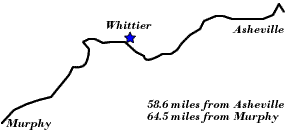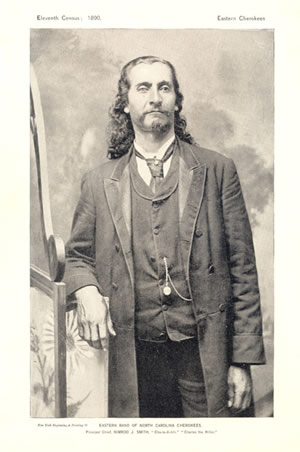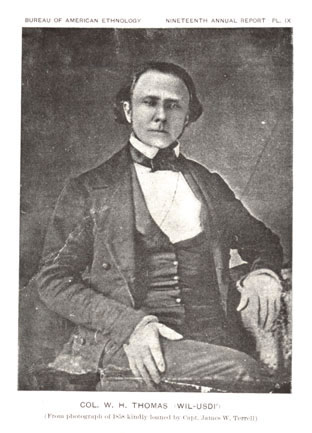Travel Western North Carolina

Following Wagon Trails - 1890s: Whittier
Swain County
Altitude: 1,858 feet
A Whit From Whittier
Whittier Jan. 28th.
“Our merchants are busy every day, which indicates a lively trade.
Having seen nothing in your paper from our place, I thought I would give you a few items.
Our enterprising friend J.R. Thomas is loading cars with paving rock for the streets of Asheville.
The log and lumber business is still lively here, and Mr. J.W.L. Arthur is keeping things lively around the depot, handling locust treenails for some ship yards in Maine. He has shipped several car loads recently the last one leaving here last Saturday, and another car is here now to be loaded tomorrow. The mumps are still raging, have had about 50 cases during the last week. I think the material is nearly exhausted, and we will soon be freed from them. Dr. Jenkins’ family dined on baked opossum yesterday. The possum attempted to make his supper off a fine Plymouth rock hen Saturday night, but the doctor’s son and daughter turned the tables on him completely. - Citizen.”
- Swain County Herald (Bryson City), January 31, 1889
In writing of his travels in western North Carolina in 1893, W.D. Mooney recounted a trip with Nimrod Jarrett Smith, the former Principal Chief of the Eastern Band of Cherokee Indians, from Yellow Hill (now Cherokee, N.C.) to Whittier, N.C. Smith became Principal Chief in 1880 and served until 1891. A full-page picture of Smith was the opening illustration in an 1892 publication by the U.S. Census Office entitled Eastern Band of Cherokees of North Carolina. Smith died not long after the appearance of Mooney’s article. The Tuckaseigee Democrat (Sylva, N.C.) newspaper carried a brief announcement of his death in its August 9, 1893, issue, “Nimrod Jarrett Smith, the well-known and universally respected Ex-Chief of the Eastern Tribe of Cherokee Indians, died at his home at Cherokee, Aug. 2.” Mooney continued his travel log by relating the trip from Whittier to Balsam, N.C., and the ensuing exploration of surrounding countryside. The comment that Nimrod Jarrett Smith was “Chesterfield in manners” derives from the reputation of the Earl of Chesterfield, Philip Dormer Stanhope, as a person of distinguished demeanor.
A Tramp through the Mountains
“The present chief, Stillwell Saunooka, is a portly, stolid-looking man. The ex-chief, John Smith [sic], or Tsalatihi, is Chesterfield in manners. His erect, military bearing is suggestive of his four years of service as a Confederate officer. He is also a Mason and is much interested in the order. . . . .
“We, that is Smith and I, left Yellow Hill on the morning of the 9th, bound for Whittier, a little station on the Richmond & Danville R.R., six miles from Yellow Hill. . . . . We two tramps forded the ‘Luftie and set out at a brisk pace for Wittier. Meeting a mountain lad, Smith asked him if we `followed the straight road to Whittier.’ `No, it’s a crooked one,’ was the reply. Smith grinned and walked on. Our plan was to take the train to Balsam Gap and then strike into the mountains once more, devoting the last two days of our tramp to the Balsam Mountains. We reached Whittier two hours before the train did. Smith wrote, while I loafed. I met Sam Owl, a noted Indian guide, who proved less taciturn than most of his race. I also heard a mountain maiden speaking of a dress pattern which she was about to buy, say, `Doggone if that ain't the one for me.’ On the train were Mr. and Mrs. Smathey, of Waynesville, whom we had met at Yellow Hill, and Mr. Smathey kindly mapped out for us a route for our two days in the Balsams, and also carried our surplus baggage on board, and to our gratification, Mr. Geo. Erdman, Princeton ’93, decided to join us. At Balsam Gap we got a good dinner, and then started up Mt. Junaluska (Plott Balsam), height 6,225 ft. Mr. Connor, an old gentleman of 75, was our guide. He is a firm believer of the curative properties of balsam, and says it will heal anything, from a seared conscience to a case of small-pox. He gathers it and sets it at $2 per pin.”
- W.D. Mooney, Forest and Stream, February 9, 1893
From ProQuest American Periodical Series Online.
William Holland Thomas (1805 - 1893) had a long and complex career as a merchant and politician as well as a decades-long, intricate relationship with the Eastern Band of Cherokee Indians. Born near Waynesville, N.C., Thomas moved into the area that is now Jackson and Swain counties, N.C., about 1817. He operated a number of trading stores and carried on wide-ranging commercial activities throughout western North Carolina and in South Carolina and Georgia. In the late 1830s Thomas purchased a large farm located at the old Cherokee town site of Stekoa, or Stecoe, in northern Jackson County, near the present-day town of Whittier.
As a North Carolina state legislator from 1848 until 1862, Thomas exerted considerable influence. The History of Jackson County (p. 229) summed up the measure of his political activities by noting that "[t]he early political history of Jackson County centers around the career of one man - William Holland Thomas."
Thomas became well-known for his role in assisting those Cherokee Indians who would later be recognized as the Eastern Band in avoiding the forced removal of the Cherokee Nation in 1838 on the "Trail of Tears." His involvement in the affairs of the Eastern Band of Cherokee Indians would continue for the following three decades, as agent, attorney, and adviser. Finally, Thomas served as a colonel in the Civil War and commanded "Thomas's Legion of Indians and Highlanders."
Regional newspapers ran obituaries after Thomas's death on May 10, 1893, and reported on his varied career. In this obituary announcement from the Tuckaseige Democrat (Sylva, N.C.) the writer makes a characteristic 19th century comment about activities judged as "civilizing" Native Americans. However, as historian John Finger noted in his article "The North Carolina Cherokees, 1838 - 1966: Traditionalism, Progressivism, and the Affirmation of State Citizenship," members of the Eastern Band found means to maintain their culture, community, and identity during the 19th century.
Death of Col. W.H. Thomas
“Col. Wm. H. Thomas died at Morganton Tuesday of last week, his remains being brought to Waynesville and there buried.”
“Col. Thomas was one of the most prominent men of Western North Carolina, being especially well known and greatly popular in this county.”
“We hope to be able to publish a more extended history of his life and character, from a more competent pen than our own, than the following sketch, which is taken from the Asheville Citizen:”
“Col. Thomas in his earlier life was for many years Indian agent in the Cherokee reservation in Western North Carolina, and also served in the State Legislature. He was a close friend of the Indians, took a deep interest in everything that tended to the further civilization of the tribe, and many of their improvements are the result of his work. He spoke the Indian language fluently.”
"Col. Thomas was one of the first to advocate the building of a railroad through this section of the country, and spent much of his time in working to this end. Perhaps 15 years ago Col. Thomas became deranged and was taken to the asylum at Raleigh, where he remained until the Morganton asylum was completed, when he was transferred to that institution. He remained there until his death.”
“Col. Thomas was about 80 years of age and leaves several children.”
- Tuckaseige Democrat (Sylva, N.C.), May 17, 1893
Whittier Dots
“Editor Times: Whittier is certainly on a boom for a few days. Prof. T.L. McLean of Knoxville, an elder brother of our townsman P.P. McLean, is teaching a writing school and has more than one hundred pupils in attendance.”
“Several married persons are taking lessons in the school.”
“The Mission school, of which Prof. Humphry has charge, is now in vacation for one week and the writing school is patronized by very nearly every-body in reach, it is being taught in the new school building. Prof. McLean has had 25 years experience in this work and has always been successful. The “Whittier High School” will begin the third and last term for the present year on Tuesday, 7th inst, and will close with the month of May. The school has done better work this year, than than [sic] ever before.”
Respectfully,
April 2nd 96.
A subscriber.
- Bryson City Times (Bryson City, N.C.), April 3, 1896
Return to the Southern Railway Map for the 1890s
Sources & Readings
- Finger, John R. The Eastern Band of Cherokees, 1819 - 1900. Knoxville: University of Tennessee Press, 1984.
- Finger, John R. “The North Carolina Cherokees, 1838 – 1966: Traditionalism, Progressivism, and the Affirmation of State Citizenship.” Journal of Cherokee Studies. Vol. V, no. 1 (Spring 1980): 17 – 29.
- George, Michael. Southern Railway’s Murphy Branch. Collegedale, Tenn.: The College Press, 1996.
- Jackson County Genealogical Society. Jackson County Heritage, North Carolina, 1992. Cullowhee, NC: JCGS, 1992 (Volume 1) and 2000 (Volume 2).
- Swain County Genealogical and Historical Society. The Heritage of Swain County, North Carolina, 1988. Bryson City, N.C.: Swain County Historical and Genealogical Society, 1988.
- U.S. Census Office. Extra Census Bulletin. Indians. Eastern Band of Cherokees of North Carolina. Eleventh Census of the United States. Washington, D.C.: United States Census Printing Office, 1892.
- Williams, Max R., ed. The History of Jackson County. Sesquicentennial ed. Sylva, NC: Jackson County Historical Association, 2001.


